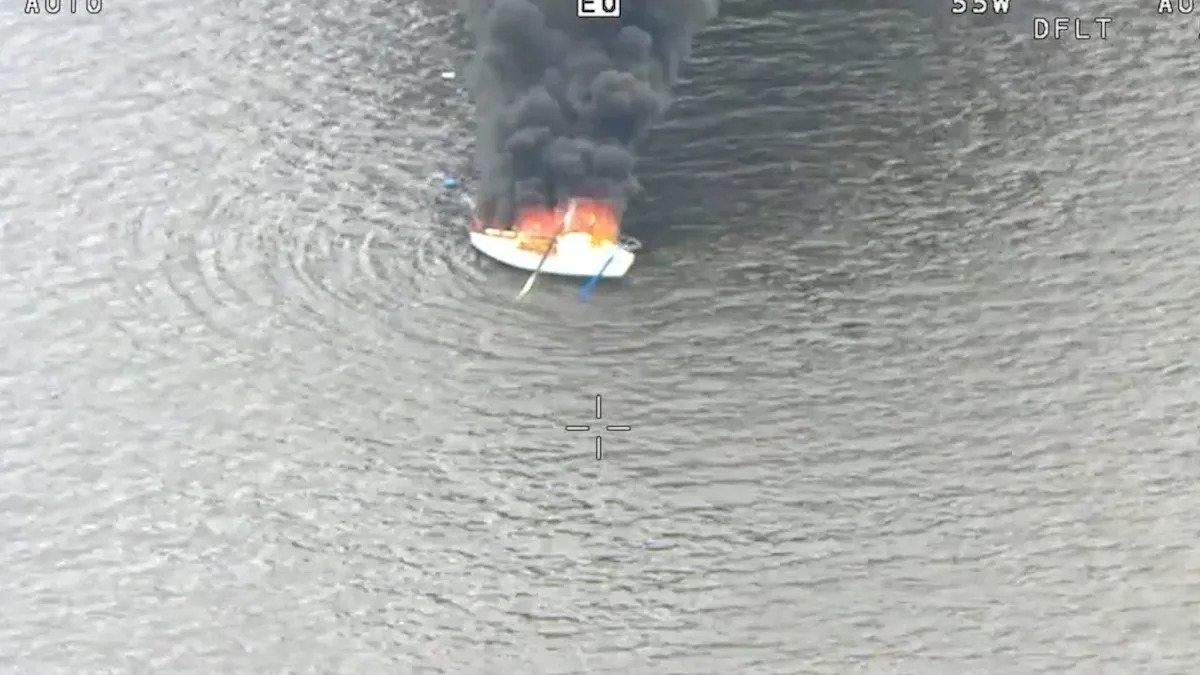Five people were saved from a sailboat engulfed in flames on July 13 by a good Samaritan on a nearby vessel in the Julington Creek and St. Johns River area, according to St. Johns County Fire Rescue.
Around 12:15 p.m., SJCFR, Jacksonville Fire Rescue Department and Clay County Fire Rescue responded to the reported boat fire. When they arrived on the scene, the boat’s five occupants were found safe in the water wearing flotation devices. The good Samaritan brought them to shore.
St. Johns County Sheriff’s Office and Florida Fish and Wildlife also responded to the scene, and the latter agency is currently investigating the cause of the fire, according to a Facebook post by SJCFR. JFRD’s Fireboat 68 extinguished the fire and no injuries were reported.
More: The story behind Sunday’s front page and the history of dragon boats here and afar
Were there any injuries in Sunday’s sailboat fire on St. Johns River?
No injuries were reported, according to a Facebook post by St. Johns County Sheriff’s Office.
Who rescued the people on burning sailboat in Jacksonville, Florida?
A nearby good Samaritan rescued all five occupants from the burning sailboat.
The occupants were found safely in the water wearing flotation devices when St. Johns County Sheriff’s Office, St. Johns County Fire Rescue, Jacksonville Fire Rescue Department, Florida Fish and Wildlife, and Clay County Fire Rescue responded to the scene.
Go Fish! Greater Jacksonville Kingfish Tournament ready for wide open waters in 2025
Watch: Sailboat catches fire on St. Johns River, 5 people rescuedHow do most boat fires start?
A common cause for a boat fire is electrical malfunction,according to Boat-Ed, an online boater safety course provider. Short circuits, overloaded circuits or faulty wiring can cause sudden fires to occur.
It is also important to store flammable materials like propane, gasoline and cleaning agents away properly to avoid the risk of a fuel leak or spill,which can lead to accidental ignition.
Do boats need a fire extinguisher onboard?
The United States Coast Guard requires recreational boats with these attributes to carry marine fire extinguishers:
-
Permanently installed fuel tank(s)
-
Spaces that are capable of trapping fumes, such as a
-
Closed stowage compartment in which combustible or flammable materials is stowed.
-
Closed compartment under thwarts and seats wherein portable fuel tanks may be stored.
-
Double bottom not sealed to the hull or that is not completely filled with flotation material.
-
What safety equipment is required on boats?
There are regulations set by the U.S. Coast Guard and state agencies requiring certain equipment to be available on your boat, depending on size of your boat.
According to the Florida Fish and Wildlife Conservation Commission, boats that range from 16 to 26 feet in length require:
-
Personal Flotation Devices: One approved wearable (Type I, II or III) PFD for each person on board or being towed on water skis etc., in addition, one throwable (Type IV) device. Devices must be USCG-approved, in serviceable condition and properly stored.
-
Class I: Every person on board under the age of 6 must wear an approved wearable (Type I, II or III) PFD while the vessel is underway.
-
Water Skier: Every person skiing or aquaplaning must wear an approved wearable (Type I, II or III) PFD. Inflatable PFDs are prohibited.
-
Fire Extinguisher: One USCG-approved 5-B type fire extinguisher is required for all recreational motorboats except outboard-powered motorboats less than 26 feet long if constructed in a manner that will not allow gas fumes to accumulate.
-
If your boat has a built-in fuel tank, an inboard engine, compartments where portable fuel tanks may be stored, or open areas between the hull and deck where flammable or explosive gases could accumulate, you must carry a fire extinguisher. Extinguisher must be USCG-approved and must be in serviceable condition.
-
-
Visual Distress Signal: Required on the high seas and coastal waters only. Must be carried for both day and nighttime use.
-
Sound-producing Device (bell, horn, whistle, etc.): Every vessel less than 12 meters (39.4 feet) in length must carry an efficient sound-producing device. The sound-producing device need not meet any particular specifications, as long as the vessel can produce signals required by the navigational rules.
-
Backfire Flame Control: An effective means of controlling backfire flame of all gasoline engines installed after April 25, 1940, except outboard motors. Must be USCG approved.
-
Ventilation (Boats built prior to Aug. 1, 1980): At least two ventilator ducts fitted with cowls or their equivalent for the purpose of properly and efficiently ventilating the bilges of every closed engine and fuel-tank compartment of boats constructed or decked over after April 25, 1940, using gasoline as fuel or other fuels having a flash point of 110 degrees or less.
-
Ventilation (Boats built after Aug. 1, 1980): At least two ventilator ducts for efficiently ventilating every closed compartment that contains a gasoline engine and every closed compartment containing a gasoline tank, except for those having permanently installed tanks that vent outside the boat and contain no unprotected electrical devices.
-
Engine compartments containing a gasoline engine with a cranking motor must contain power operated exhaust blowers that can be controlled from the instrument panel.
-
-
Vessel Lighting: Recreational vessels are required to display navigation lights between sunset and sunrise, and during periods of reduced visibility (fog, rain, haze, etc).
How to use a boat fire extinguisher
Drive a Boat USA recommends using the P.A.S.S. method to put out a boat fire:
-
Aim the nozzle at the base of the fire
-
Squeeze the two levers together or press the handle
-
Sweep back and forth to spread the contents at the base of the fire
Continue until the fire is completely out. Fire extinguisher must be USCG-approved.
This article originally appeared on Florida Times-Union: Video: 5 people rescued from Florida sailboat fire on St. Johns River
